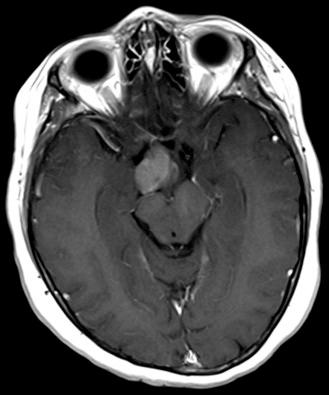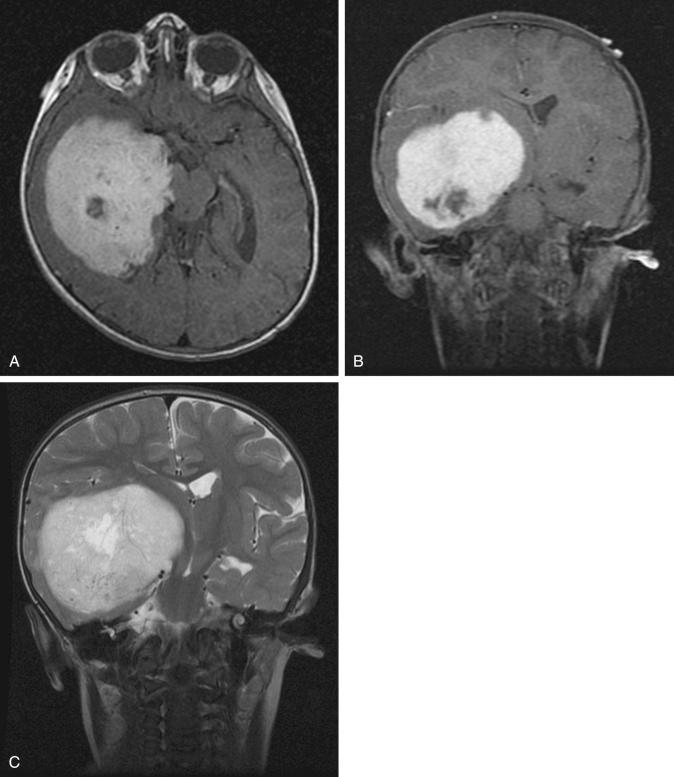Physical Address
304 North Cardinal St.
Dorchester Center, MA 02124
The most common solid tumor in pediatrics is a central nervous system tumor, accounting for 20% to 25% of all childhood neoplasms.
In childhood, 75% of congenital brain tumors are supratentorial. Initial presenting symptoms can include hydrocephalus, palpable skull mass, focal neurologic deficit, vision change, and endocrinopathies.
Upon initial presentation, tumors are diagnosed through cranial imaging with computed tomography or magnetic resonance imaging. Endocrinologic laboratory studies are ordered if indicated by symptoms.
Neurocutaneous disorders that genetically predispose children to specific brain tumors include neurofibromatosis type I, neurofibromatosis type 2, and tuberous sclerosis complex.
Multiple tumor histologies are seen in pediatric supratentorial tumors, including astrocytic and glial derived tumors, neural and neuroglial tumors, ependymal tumors, embryonal or supratentorial primitive neuroectodermal tumors, malignant rhabdoid tumors, choroid plexus tumors, pineal region tumors, pituitary tumors, meningeal tumors, germ cell tumors, and hematopoietic, skull, or dermal-derived tumors.
The most common solid tumor in pediatrics is a central nervous system tumor, accounting for 20% to 25% of all childhood neoplasms. Although the posterior fossa is the most common location for these tumors in pediatrics, there are many supratentorial tumors, both common and uncommon, that can be seen in neurosurgical practice. Interestingly, 75% of congenital childhood brain tumors are supratentorial. The initial presenting symptoms for supratentorial tumors depend on location and can include hydrocephalus for intraventricular tumors, palpable skull masses for skull-based tumors, mass effect and focal neurologic deficit for hemispheric tumors, vision change for tumors of the optic apparatus, and endocrinopathies for tumors involving the hypothalamic-pituitary axis. Genetic predisposition for specific brain tumors must be understood when taking care of children with neurocutaneous syndromes (ie, phakomatoses) such as neurofibromatosis type 1 (NF1), neurofibromatosis type 2 (NF2), and tuberous sclerosis complex (TSC). Upon initial patient presentation, tumors are diagnosed through cranial imaging with computed tomography (CT) or magnetic resonance imaging (MRI). Treatment can be varied, and long-term follow-up is often indicated through serial imaging to evaluate for potential reoccurrence. Multiple tumor histologies are seen in pediatric supratentorial tumors, both benign and malignant. Basic histologic subgroups include astrocytic and glial-derived tumors, neural and neuroglial tumors, ependymal tumors, embryonal or supratentorial primitive neuroectodermal tumors (PNETs), malignant rhabdoid tumors such as atypical teratoid rhabdoid tumors (ATRTs), choroid plexus tumors, pineal region tumors, pituitary tumors, meningeal tumors, germ cell tumors, and hematopoietic, skull, or dermal-derived tumors ( Table 13.1 ).
| Astrocyte/Glial |
|
| Neuroglial |
|
| Ependymal |
|
| Choroid Plexus |
|
| Pineal Region |
|
| Germ Cell Tumors |
|
| Supratentorial Embryonal |
|
| Meningioma/Meningeal Sarcoma |
|
| Pituicytoma (WHO I) |
| Hematopoietic |
|
| Skull/Scalp |
|
Supratentorial astrocyte-derived tumors seen in pediatrics include pilocytic astrocytoma, pilomyxoid astrocytoma, pleomorphic xanthoastrocytoma, subependymal giant cell astrocytoma, fibrillary astrocytoma, anaplastic astrocytoma, and glioblastoma. Low-grade gliomas (LGGs), consisting of World Health Organization (WHO) I and II gliomas, account for 60% of hemispheric tumors in children, and they occur at an incidence of five per million children per year. The mean age of diagnosis is around 6 to 11 years of age. These typically slow-growing benign tumors may present with symptoms of mass effect, seizure, hydrocephalus, or focal deficit, such as vision loss if present in the optic nerve. Although it is typical for adult patients with WHO II astrocytomas to eventually have malignant transformation, this is less common in the pediatric population.
Supratentorial pilocytic astrocytoma is a WHO grade I tumor that can be hemispheric or deep. It can involve the hypothalamus and optic apparatus, most often in patients with NF1. These tumors are typically well circumscribed and contrast enhancing. Histologically the tumors consist of glial fibrillary acidic protein (GFAP)–positive bipolar tumor cells with elongated nuclei and fine cytoplasmic processes. There can be areas of microcysts with Rosenthal fibers. Treatment is maximal safe resection, and gross total surgical resection typically prevents regrowth.
Tumors of the optic pathway in patients with NF1 can be indolent ( Fig. 13.1 ). Rather than resection of a functioning optic nerve, these tumors are typically followed with serial imaging and treated with chemotherapy if there is significant tumor enlargement or vision loss. Around half of patients with optic pathway gliomas have NF1.

Other types of supratentorial astrocytomas are less common in the pediatric population.
Pilomyxoid astrocytomas are typically present in very young children (median 10 months) but have been seen in older children ( Fig. 13.2 ). They are most commonly seen in the hypothalamus or optic chiasm. They are typically T1 hypointense and T2 hyperintense with homogeneous enhancement. Pleomorphic xanthoastrocytomas comprise less than 1% of all astrocytic tumors, and two thirds of patients are younger than 18 years old. Imaging often reveals a tumor mass with adjoining cyst with minimal peritumoral edema. Histology is variable with cellular pleomorphism and frequent intranuclear inclusions. Subependymal giant cell astrocytomas (SEGAs) arise from the walls of the lateral ventricle in patients with tuberous sclerosis complex. Histology consists of large astrocytic cells with abundant eosinophilic cytoplasm, and cells may react to both glial and neuronal markers. Treatment historically has been surgical resection in patients presenting with hydrocephalus, but a new chemotherapy agent, the mTOR inhibitor everolimus, has proved moderately effective in treating these tumors in patients with TSC, though it has to be taken indefinitely. Thalamic gliomas in childhood are a special entity, much like diffuse intrinsic pontine glioma. Thalamic glioma often behaves differently than glioma in other locations, and surgical morbidity from gross total resection of these tumors can often be unacceptable. Thalamic gliomas constitute just under 5% of all intracranial tumors, half of which present in childhood. Diffuse astrocytoma (WHO II) is uncommon in young children, becoming more common in the late teens to early adulthood. Histology reveals well-differentiated neoplastic astrocytes on a loose microcystic tumor matrix, often with normal to moderate increase in cellularity. Anaplastic astrocytomas (WHO grade III) and glioblastomas (WHO grade IV) have been documented in childhood, but these tumors are more frequently seen in adults. Around 6.5% of all newly diagnosed childhood intracranial tumors are high-grade gliomas. The genetic mutations of these tumors may be different in pediatrics than in adults, as there are few reports of low-grade gliomas transforming into high-grade gliomas in the pediatric literature. This malignant transformation is often seen in low-grade gliomas in adult patients. Pediatric high-grade gliomas have been observed to have more frequent gains in chromosomes 1p, 2q, and 21q with losses in chromosomes 6q, 11q, and 16q. Pediatric patients with high-grade gliomas tend to have a slightly better median survival rate than adult patients with a similar histologic-grade tumor. MRI typically shows an enhancing mass with peritumoral edema and possibly central necrosis. Treatment typically includes maximal safe surgical resection with adjuvant chemotherapy and radiation therapy. Prognosis is poor compared to other pediatric tumors, with a 10% to 30% 2-year survival.

Become a Clinical Tree membership for Full access and enjoy Unlimited articles
If you are a member. Log in here